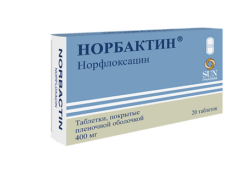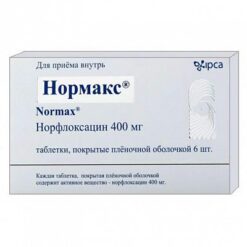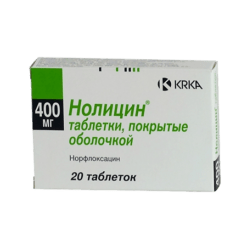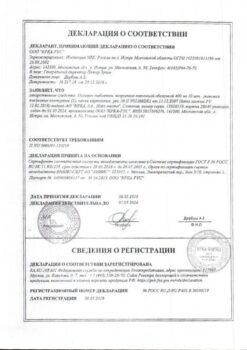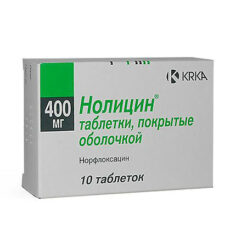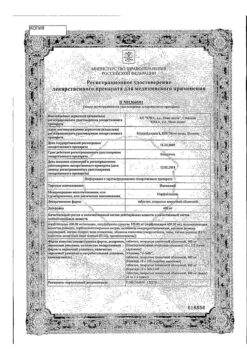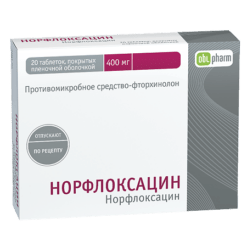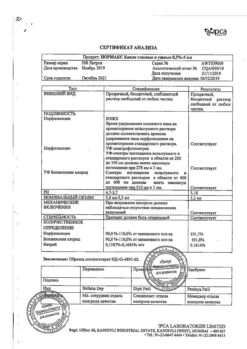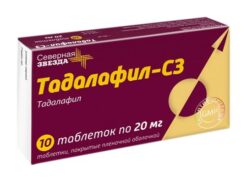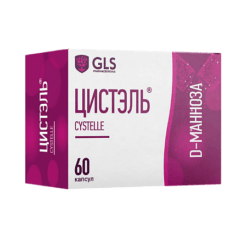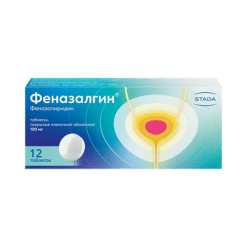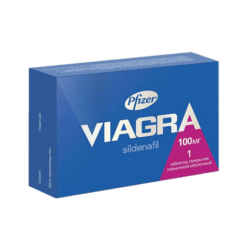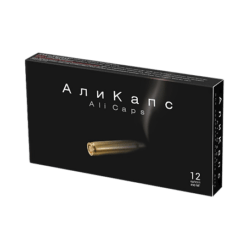No products in the cart.
Norfloxacin, 400 mg 20 pcs
€11.96 €10.46
Description
Pharmacotherapeutic group: antimicrobial agent – fluoroquinolone
ATC code: S01AE02
Pharmacodynamics:
Indications
Indications
Infectious and inflammatory diseases caused by microorganisms sensitive to norfloxacin: urinary tract infections (except for acute and chronic complicated pyelonephritis), chronic bacterial prostatitis, uncomplicated gonorrhea, salmonellosis, shigellosis.
Prevention of traveler’s diarrhea and prevention of sepsis in patients with neutropenia.
Pharmacological effect
Pharmacological effect
Pharmacotherapeutic group: antimicrobial agent – fluoroquinolone
ATX code: S01AE02
Pharmacodynamics:
Special instructions
Special instructions
In some cases, after the first use of the drug, hypersensitivity reactions (anaphylactic/anaphylactoid reactions) may develop, which should be reported to your doctor immediately. Very rarely, even after the first use of the drug, anaphylactic reactions can progress to life-threatening anaphylactic shock. In these cases, treatment with norfloxacin should be stopped and the necessary therapeutic measures (including anti-shock) should be started immediately.
During treatment with norfloxacin, patients should receive a sufficient amount of fluid (under the control of diuresis).
During the period of therapy, an increase in the prothrombin index is possible (during surgical interventions, the state of the blood coagulation system should be monitored).
During treatment with norfloxacin, exposure to ultraviolet rays should be avoided, incl. direct sunlight.
Norfloxacin, like other fluoroquinolones, can cause tendinitis and tendon rupture. Risk factors: age over 60 years, taking glucocorticosteroids, heart or lung kidney transplantation, increased physical activity, chronic renal failure, history of tendon damage (including rheumatoid arthritis). These phenomena may occur several months after stopping the drug. If pain appears in the tendons or at the first signs of tenosynovitis, you should stop the drug and consult a doctor. During therapy with norfloxacin, it is recommended to avoid excessive physical activity. Norfloxacin may lower the seizure threshold and cause seizures; fluoroquinolones may also stimulate the central nervous system causing tremors, toxic psychoses, anxiety, confusion and hallucinations; increased intracranial pressure. If seizures develop, use of the drug should be discontinued.
Norfloxacin can lead to the development of pseudomembranous colitis caused by Clostridium difficile. In this case, it is necessary to discontinue the drug and prescribe appropriate treatment (including the use of oral vancomycin or metronidazole). Drugs that inhibit intestinal motility are contraindicated.
Cases of cholestatic hepatitis have been reported with the use of norfloxacin. The patient should be informed that if symptoms of liver dysfunction occur (anorexia, jaundice, dark urine, itching, abdominal pain), consult a doctor before continuing treatment with norfloxacin.
Not effective against syphilis.
In patients treated with quinolones, including norfloxacin, cases of sensory or sensorimotor axonal polyneuropathy affecting small and/or large axons and leading to paresthesia, hypoesthesia, dysesthesia and weakness have been described. Symptoms may appear soon after starting use and may be irreversible. Patients undergoing treatment with norfloxacin should be warned of the need to immediately consult a doctor if symptoms of neuropathy occur, including pain, burning, tingling, numbness, weakness or other sensory disturbances, including tactile pain, temperature vibration sensitivity and position sense (see section “Side Effects”) Norfloxacin should be discontinued immediately.
To avoid the formation of norfloxacin crystals in the kidneys, do not exceed recommended doses; It is necessary to take the tablets with a sufficient amount of liquid.
Impact on the ability to drive vehicles. Wed and fur.:
Care must be taken when driving a car and engaging in other potentially dangerous activities that require increased concentration and speed of psychomotor reactions.
Active ingredient
Active ingredient
Norfloxacin
Composition
Composition
For 1 tablet:
Active substance:
norfloxacin 400.0 mg.
Excipients (core): lactose monohydrate (milk sugar) – 85.0 mg, microcrystalline cellulose – 98.0 mg, croscarmellose sodium – 37.0 mg, water – 10.0 mg, povidone-K25 – 24.0 mg, magnesium stearate – 6.0 mg.
Excipients (shell): hypromellose – 11.0 mg, macrogol-4000 – 3.0 mg, titanium dioxide – 6.0 mg.
Pregnancy
Pregnancy
The safety of use during pregnancy and lactation has not been studied. The drug is contraindicated during pregnancy. If it is necessary to prescribe the drug during lactation, breastfeeding should be stopped.
Contraindications
Contraindications
– hypersensitivity to norfloxacin components of the drug and other quinolones;
– deficiency of glucose-6-phosphate dehydrogenase;
– tendonitis, tendon rupture caused by taking fluoroquinolones (including a history);
– hereditary lactose intolerance, lactase deficiency or glucose-galactose malabsorption;
– childhood and adolescence (up to 18 years);
– pregnancy and lactation period.
With caution:
Atherosclerosis of cerebral vessels cerebrovascular accident (history) epilepsy organic diseases of the central nervous system predisposition to convulsive reactions psychosis and other mental disorders in history renal/liver failure myasthenia gravis hepatic porphyria diabetes mellitus congenital long QT syndrome heart disease (heart failure myocardial infarction bradycardia) electrolyte imbalance (for example for hypokalemia, hypomagnesemia) old age in women, simultaneous use of drugs that prolong the QT interval (antiarrhythmic drugs of classes IA and III, tricyclic and tetracyclic antidepressants, neuroleptics, macrolides, antifungal imidazole derivatives, some antihistamines, including astemizole terfenadine ebastine) agents for general anesthesia from the group of barbiturates; medications that lower blood pressure.
Side Effects
Side Effects
From the nervous system: dizziness headache anxiety tingling in the fingers drowsiness anxiety depression insomnia sleep disturbance.
From the digestive system: nausea, abdominal pain, anorexia, diarrhea, pain in the rectum or anus, constipation, dyspepsia, flatulence, vomiting, dry oral mucosa, heartburn, loose stools, bitter taste in the mouth, ulceration of the oral mucosa, itching of the anus.
From the hematopoietic organs: leukopenia, thrombocytopenia, eosinophilia, neutropenia.
From the skin: itching, rash, erythema, urticaria.
From the senses: blurred visual perception.
From the musculoskeletal system: bursitis, swelling of the hands and feet.
From the cardiovascular system: myocardial infarction, palpitations.
From the urinary system: renal colic.
Laboratory indicators: increased activity of “liver” transaminases (alanine aminotransferase aspartate aminotransferase alkaline phosphatase lactate dehydrogenase) proteinuria decreased hematocrit and hemoglobin increased urea concentration in the blood hypercreatininemia glycosuria.
Other: hyperhidrosis asthenia back pain fever chills chest pain dysmenorrhea edema allergic reactions fatigue.
Post-marketing experience.
From the nervous system: convulsions myoclonus tremor peripheral neuropathy Guillain-Barre syndrome ataxia paresthesia hypoesthesia mental disorders (including confusion) irritability fear.
Allergic reactions: anaphylactic/anaphylactoid reactions, angioedema, shortness of breath, vasculitis, urticaria.
From the skin: toxic epidermal necrolysis Stevens-Johnson syndrome erythema multiforme exfoliative dermatitis photosensitivity leukocytoclastic vasculitis drug rash with eosinophilia and systemic symptoms (DRESS syndrome).
From the digestive system: pseudomembranous colitis, hepatitis, cholestatic jaundice, pancreatitis, stomatitis, liver failure (including death).
From the cardiovascular system: prolongation of the QT interval, ventricular arrhythmia, incl. tachycardia of the “pirouette” type.
From the urinary system: increased urea content in plasma, interstitial nephritis, renal failure.
From the musculoskeletal system: arthritis arthralgia myalgia tendinitis tendon rupture exacerbation of myasthenia gravis increased creatine phosphokinase activity muscle spasms.
From the hematopoietic organs: agranulocytosis, hemolytic anemia.
From the senses: hearing loss, tinnitus, diplopia, dysgeusia.
Other side effects when taking quinolones: agranulocytosis albuminuria candiduria crystalluria cylindruria dysphagia hyperglycemia hypercholesterolemia hyperkalemia hypertriglyceridemia hematuria liver necrosis hypoglycemia nystagmus postural hypotension prolongation of prothrombin time vaginal candidiasis.
Interaction
Interaction
With the simultaneous use of norfloxacin and theophylline, the concentration of theophylline in the blood plasma should be monitored and its dose adjusted as norfloxacin reduces the clearance of theophylline by 25%.
Reduces the effect of nitrofurans.
Norfloxacin may enhance the therapeutic effect of cyclosporine and indirect anticoagulants; in some cases, when using norfloxacin with cyclosporine, an increase in the concentration of creatinine in the blood plasma was observed; therefore, in such patients, monitoring of this indicator as well as the plasma concentration of cyclosporine is necessary.
The simultaneous use of norfloxacin and antacids containing aluminum or magnesium hydroxide, as well as preparations containing zinc iron ions sucralfate leads to a decrease in the absorption of norfloxacin (the interval between their administration should be at least 2 hours).
Concomitant use with drugs (including non-steroidal anti-inflammatory drugs) that lower the seizure threshold can lead to the development of seizures.
Concomitant use with glucocorticosteroids may increase the risk of tendonitis or tendon rupture.
Norfloxacin may enhance the therapeutic effect of hypoglycemic drugs (sulfonylurea derivatives), and therefore it is necessary to monitor the concentration of glucose in the blood plasma.
The simultaneous use of norfloxacin with drugs that have the potential to lower blood pressure can cause a sharp decrease in blood pressure. In this regard, in such cases, as well as when administered simultaneously with barbiturates and other drugs for general anesthesia, heart rate, blood pressure and ECG readings should be monitored.
Norfloxacin in vitro inhibits the CYP1A2 isoenzyme, which can lead to an increase in the concentration of its substrates in the blood plasma (including caffeine, clozapine, ropinirole, tacrine, theophylline, tizanidine), and therefore monitoring of patients taking these drugs simultaneously with norfloxacin is necessary.
Probenecid may decrease the excretion rate of norfloxacin.
When used simultaneously with drugs that prolong the QT interval, a more pronounced prolongation of the latter is possible.
Overdose
Overdose
Symptoms: nausea, vomiting, diarrhea, dizziness, drowsiness, “cold” sweat, cramps, puffy face.
Treatment: gastric lavage, adequate hydration therapy with forced diuresis and symptomatic therapy. Requires examination and observation in a hospital for several days. There is no specific antidote.
Storage conditions
Storage conditions
In a place protected from light at a temperature not exceeding 25 ° C. Keep out of the reach of children.
Shelf life
Shelf life
3 years. Do not use the drug after the expiration date.
Manufacturer
Manufacturer
Ozon, Russia
Additional information
| Shelf life | 3 years. Do not use the drug after the expiration date. |
|---|---|
| Conditions of storage | Store in a dark place at a temperature not exceeding 25 °С. Keep out of reach of children. |
| Manufacturer | Ozon, Russia |
| Medication form | pills |
| Brand | Ozon |
Other forms…
Related products
Buy Norfloxacin, 400 mg 20 pcs with delivery to USA, UK, Europe and over 120 other countries.


